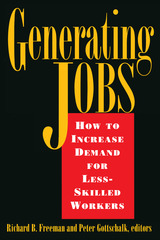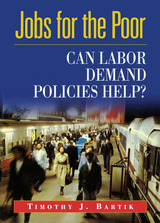2 books about Labor dem

Generating Jobs
How to Increase Demand for Less-Skilled Workers
Richard B. Freeman
Russell Sage Foundation, 1998
The American economy is in danger of leaving its low-skilled workers behind. In the last two decades, the wages and employment levels of the least educated and experienced workers have fallen disastrously. Where willing workers once found ready employment at reasonable wages, our computerized, service-oriented economy demands workers who can read and write, master technology, deal with customers, and much else. Improved education and training will alleviate this problem in the long run, but educating the new workforce will take a substantial national investment over many years. In the meantime, we face increasingly acute questions about how to include low-skill workers in today's economy. Generating Jobs takes a hard look at these questions, and asks whether anything can be done to improve the lot of low-skilled workers by intervening in the labor market on their behalf. These micro demand-side policies seek to improve wages and employment levels—either by lowering the costs of hiring low-skilled workers through employer subsidies, or by raising wage levels, benefit levels, or hours of employment, or by providing employment via government jobs. Although these policies are not currently popular in the U.S., they have long been used in many countries. Generating Jobs provides a clear-eyed assessment of this history, and asks if any of these policies might be applicable to the current problems of low-skilled workers in the United States. The results are surprising. Several recently touted panaceas turn out to be costly and ineffective in the American labor market. Enterprise zones, for instance, are an expensive way of moving jobs into areas of high unemployment, costing as much as $60,000 per job. Similarly, job-sharing, which has had uneven success in Europe, turns out to be ill-suited to conditions in the U.S., where wages are relatively low and workers need to work long hours to maintain income. On the other hand, a number of older, less flashy policies turn out to have real, if modest, benefits. Wage subsidies have increased employment among qualifying workers, and public employment policies can increase the number of workers from targeted groups working during the program. While acknowledging that many solutions are counterproductive, this definitive review of active labor market policies shows that many programs can offer real help. More than any rhetoric, Generating Jobs is the best guide to future action and a serious response to those who claim that nothing can be done.
[more]

Jobs for the Poor
Can Labor Demand Policies Help?
Timothy J. Bartik
Russell Sage Foundation, 2001
Even as the United States enjoys a booming economy and historically low levels of unemployment, millions of Americans remain out of work or underemployed, and joblessness continues to plague many urban communities, racial minorities, and people with little education. In Jobs for the Poor, Timothy Bartik calls for a dramatic shift in the way the United States confronts this problem. Today, most efforts to address this problem focus on ways to make workers more employable, such as job training and welfare reform. But Bartik argues that the United States should put more emphasis on ways to increase the interest of employers in creating jobs for the poor—or the labor demand side of the labor market. Bartik's bases his case for labor demand policies on a comprehensive review of the low-wage labor market. He examines the effectiveness of government interventions in the labor market, such as Welfare Reform, the Earned Income Tax Credit, and Welfare-to-Work programs, and asks if having a job makes a person more employable. Bartik finds that public service employment and targeted employer wage subsidies can increase employment among the poor. In turn, job experience significantly increases the poor's long-run earnings by enhancing their skills and reputation with employers. And labor demand policies can avoid causing inflation or displacing other workers by targeting high-unemployment labor markets and persons who would otherwise be unemployed. Bartik concludes by proposing a large-scale labor demand program. One component of the program would give a tax credit to employers in areas of high unemployment. To provide disadvantaged workers with more targeted help, Bartik also recommends offering short-term subsidies to employers—particularly small businesses and nonprofit organizations—that hire people who otherwise would be unlikely to find jobs. With experience from subsidized jobs, the new workers should find it easier to obtain future year-round employment. Although these efforts would not catapult poor families into the middle class overnight, Bartik offers a powerful argument that having a full-time worker in every household would help improve the lives of millions. Jobs for the Poor makes a compelling case that full employment can be achieved if the country has the political will and adopts policies that address both sides of the labor market. Copublished with the W. E. Upjohn Institute for Economic Research
[more]
READERS
Browse our collection.
PUBLISHERS
See BiblioVault's publisher services.
STUDENT SERVICES
Files for college accessibility offices.
UChicago Accessibility Resources
home | accessibility | search | about | contact us
BiblioVault ® 2001 - 2024
The University of Chicago Press









